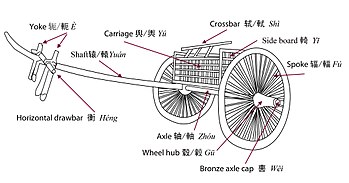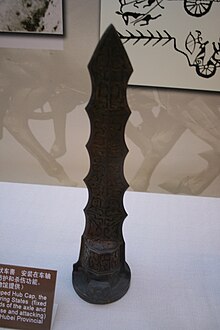
A polearm or pole weapon is a close combat weapon in which the main fighting part of the weapon is fitted to the end of a long shaft,typically of wood,extending the user's effective range and striking power. Polearms are predominantly melee weapons,with a subclass of spear-like designs fit for thrusting and/or throwing. Because many polearms were adapted from agricultural implements or other fairly abundant tools,and contained relatively little metal,they were cheap to make and readily available. When belligerents in warfare had a poorer class who could not pay for dedicated military weapons,they would often appropriate tools as cheap weapons. The cost of training was comparatively low,since these conscripted farmers had spent most of their lives using these "weapons" in the fields. This made polearms the favoured weapon of peasant levies and peasant rebellions the world over.
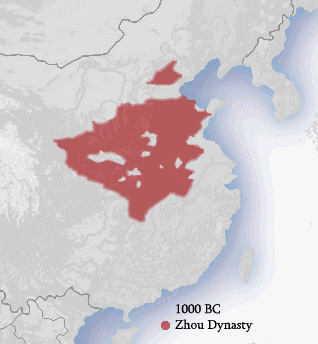
The Zhou dynasty was a royal dynasty of China that followed the Shang dynasty. Having lasted 789 years,the Zhou dynasty was the longest dynastic regime in Chinese history. The military control of ancient China by the royal house,surnamed Ji,lasted from 1046 until 771 BC for a period known as the Western Zhou,and the political sphere of influence it created continued well into the Eastern Zhou period for another 500 years. The establishment date of 1046 BC is supported by the Xia–Shang–Zhou Chronology Project and David Pankenier,but David Nivison and Edward L. Shaughnessy date the establishment to 1045 BC.

The Shang dynasty,also known as the Yin dynasty,was a Chinese royal dynasty that ruled in the Yellow River valley during the second millennium BC,traditionally succeeding the Xia dynasty and followed by the Western Zhou dynasty. The classic account of the Shang comes from texts such as the Book of Documents,Bamboo Annals and Records of the Grand Historian. Modern scholarship dates the dynasty between the 16th to 11th centuries BC,with more agreement surrounding the end date than beginning date.
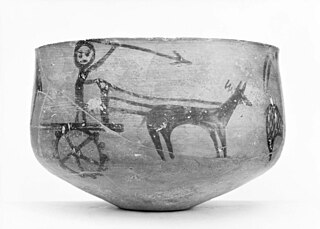
A chariot is a type of cart driven by a charioteer,usually using horses to provide rapid motive power. The oldest known chariots have been found in burials of the Sintashta culture in modern-day Chelyabinsk Oblast,Russia,dated to c. 1950–1880 BCE and are depicted on cylinder seals from Central Anatolia in Kültepe dated to c. 1900 BCE. The critical invention that allowed the construction of light,horse-drawn chariots was the spoked wheel.

The Warring States period was an era in ancient Chinese history characterized by warfare,bureaucratic and military reform,and political consolidation. It followed the Spring and Autumn period and concluded with the wars of conquest that saw the state of Qin annex all the other contender states by 221 BC and found the Qin dynasty,the first imperial dynasty in Chinese history.

Yinxu is the site of one of the ancient and major historical capitals of China. It is the source of the archeological discovery of oracle bones and oracle bone script,which resulted in the identification of the earliest known Chinese writing. The archeological remnants known as Yinxu represent the ancient city of Yin,the last capital of China's Shang dynasty which existed through eight generations for 255 years,and through the reign of 12 kings. Yinxu was discovered,or rediscovered,in 1899. It is now one of China's oldest and largest archeological sites,and was selected as a UNESCO World Heritage Site in 2006. Yinxu is located in northernmost Henan province near the modern city of Anyang,and near the Hebei and Shanxi province borders. Public access to the site is permitted.
The recorded military history of China extends from about 2200 BC to the present day. Chinese pioneered the use of crossbows,advanced metallurgical standardization for arms and armor,early gunpowder weapons,and other advanced weapons,but also adopted nomadic cavalry and Western military technology. China's armies also benefited from an advanced logistics system as well as a rich strategic tradition,beginning with Sun Tzu's The Art of War,that deeply influenced military thought.
Ancient warfare is war that was conducted from the beginning of recorded history to the end of the ancient period. The difference between prehistoric and ancient warfare is more organization oriented than technology oriented. The development of first city-states,and then empires,allowed warfare to change dramatically. Beginning in Mesopotamia,states produced sufficient agricultural surplus. This allowed full-time ruling elites and military commanders to emerge. While the bulk of military forces were still farmers,the society could portion off each year. Thus,organized armies developed for the first time. These new armies were able to help states grow in size and become increasingly centralized.
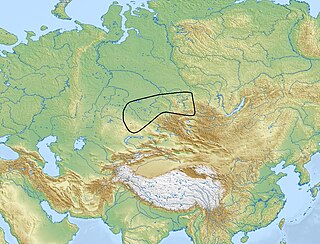
The Karasuk culture describes a group of late Bronze Age societies who ranged from the Aral Sea to the upper Yenisei in the east and south to the Altai Mountains and the Tian Shan in ca. 1500–800 BC.

The dagger-axe is a type of pole weapon that was in use from the Longshan culture until the Han dynasty in China. It consists of a dagger-shaped blade,mounted by its tang to a perpendicular wooden shaft. The earliest dagger-axe blades were made of stone. Later versions used bronze. Jade versions were also made for ceremonial use. There is a variant type with a divided two-part head,consisting of the usual straight blade and a scythe-like blade.
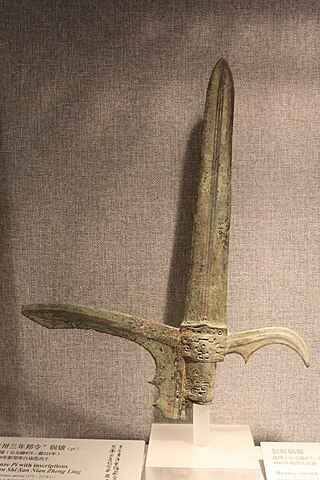
The ji was a Chinese polearm,sometimes translated into English as spear or halberd,though they are fundamentally different weapons. They were used in one form or another for over 3000 years,from at least as early as the Zhou dynasty,until the end of the Qing dynasty. They are still used for training purposes in many Chinese martial arts.

Deer stones,sometimes called the Deer stone-khirigsuur complex (DSKC) in reference to neighbouring khirigsuur tombs,are ancient megaliths carved with symbols found largely in Siberia and Mongolia. The name comes from their carved depictions of flying deer. The "Deer stones culture" relates to the lives and technologies of the late Bronze Age peoples associated with the deer stones complexes,as informed by archaeological finds,genetics and the content of deer stones art.
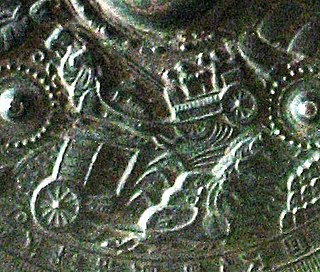
Horses in East Asian warfare are inextricably linked with the strategic and tactical evolution of armed conflict throughout the course of East Asian military history. A warrior on horseback or horse-drawn chariot changed the balance of power between the warring civilizations throughout the arc of East Asian military history.
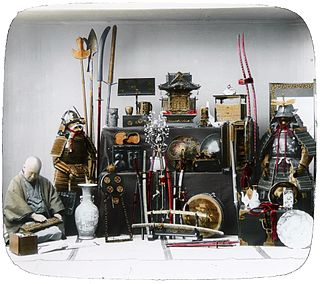
Major innovations in the history of weapons have included the adoption of different materials –from stone and wood to different metals,and modern synthetic materials such as plastics –and the developments of different weapon styles either to fit the terrain or to support or counteract different battlefield tactics and defensive equipment.

The Xianyun was an ancient nomadic tribe that invaded the Zhou dynasty. This Chinese exonym is written with xian獫 or 玁 "long-snouted dog",and this "dog" radical 犭is commonly used in graphic pejorative characters. "Xianyun" was the preferred designation for northern tribes during the Zhou dynasty,earlier designations being the Xunyu,Guifang,and later ones being the Xiongnu,during the Han dynasty.

Guifang was an ancient ethnonym for a northern people that fought against the Shang Dynasty. Chinese historical tradition used various names,at different periods,for northern tribes such as Guifang,Rong,Di,Xunyu,Xianyun,or Xiongnu peoples. This Chinese exonym combines gui and fang,a suffix referring to "non-Shang or enemy countries that existed in and beyond the borders of the Shang polity."
The following outline is provided as an overview of and topical guide to ancient China:

The military of the Warring States refers primarily to the military apparatuses of the Seven Warring States which fought from around 475 BC to 221 BC when the state of Qin conquered the other six states,forming China's first imperial dynasty,the Qin dynasty.

"Hymn to the Fallen" (Jiu Ge) is a Classical Chinese poem which has been preserved in the Nine Songs section of the ancient Chinese poetry anthology,the Chu ci,or The Songs of Chu,which is an ancient set of poems. Together,these poems constitute one of the 17 sections of the poetry anthology which was published under the title of the Chuci. Despite the "Nine" in the title,the number of these poetic pieces actually consists of eleven separate songs,or elegies. This set of verses seems to represent some shamanistic dramatic practices of the Yangzi River valley area involving the invocation of divine beings and seeking their blessings by means of a process of courtship. The poetry consists of lyrics written for performance as part of a religious drama,however the lack of stage directions or indications of who is supposed to be singing at any one time or whether some of the lines represent lines for a chorus makes an accurate reconstruction of how such a shamanic drama would actually have been performed quite uncertain;although,there are internal textual clues,for example indicating the use of spectacular costumes for the performers,and an extensive orchestra. Although not precisely dated,"Hymn to the Fallen" dates from the end of the late the Warring States period,ended 221 BCE,with possible revisions in the Han dynasty,particularly during the reign of Han Wudi,during 141 to 87 BCE. The poem has been translated into English by David Hawkes as "Hymn to the Fallen". "Guo shang" is a hymn to soldiers killed in war. Guó (國) means the "state","kingdom",or "nation". Shāng (殤) means to "die young". Put together,the title refers to those who meet death in the course of fighting for their country. David Hawkes describes it as "surely one of the most beautiful laments for fallen soldiers in any language".

Xuzhou Museum is a comprehensive museum of historical Chinese art in Xuzhou,Jiangsu,China,which was founded in 1959. Originally the site of one of the Qianlong Emperor's Palaces at the northern foot of Yunlong Mountain,the Xuzhou Museum was established in 1959,expanded in 1999,then rebuilt and extended in 2010,with work completed in 2012. At present,it encompasses an area of 40,000 square meters. The museum includes a four-story exhibition building and administers the Xanadu Palace and Stone Tablet Garden of the Qianlong Emperor of the Qing dynasty built for his inspection tour of the south of the Yangtze River in 1757. It also administers three tombs of the Pengcheng King of the Eastern Han dynasty in Tushan,that includes an excavation site of Han dynasty terracotta warriors and horses.
